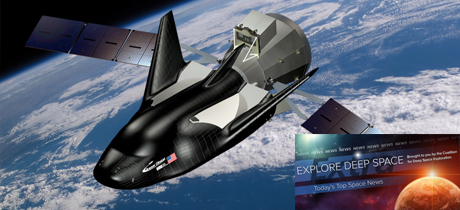In Today’s Deep Space Extra… Sierra Nevada selects ULA to rocket Dream Chaser to the International Space Station (ISS). NASA announced Wednesday it will study two potential secondary mission spacecraft, one of which could be selected to launch with the agency’s Interstellar Mapping and Acceleration Probe in late 2024.
Human Space Exploration
Private Dream Chaser space plane will ride new Vulcan rocket for NASA cargo launches
Coalition Members in the News – Northrop Grumman, United Launch Alliance
Space.com (8/14): On Wednesday, Sierra Nevada announced it has selected United Launch Alliance (ULA) and the new Vulcan Centaur rocket for launch services for the company’s winged, reusable Dream Chaser spacecraft in resupplying the six person International Space Station (ISS) through 2024. Sierra Nevada is one of three companies selected by NASA in January 2016 to launch cargo to the Space Station under a second phase of Commercial Resupply Services agreements. Sierra Nevada’s initial launch is planned for late 2021. Under the second phase, Northrop Grumman’s Cygnus and SpaceX’s Dragon will continue to launch cargo to the Station as well.
Space Science
NASA selects proposals to further study the fundamental nature of space
Physics.org (814): NASA announced Wednesday it will study two potential secondary mission spacecraft, one of which could be selected to launch with the agency’s Interstellar Mapping and Acceleration Probe in late 2024. Each option will be the focus of a nine month, $400,000 study to assess its merits. One would image the boundary between the sun’s powerful magnetic influence and interstellar space, the other the boundary between the Earth’s outer most atmospheric layer and its interactions with the solar wind. The first could help to predict the threat posed by cosmic radiation to astronauts on deep space missions. The second could help to assess the impact of solar weather on radio transmissions.
Methane on Mars isn’t being released by wind erosion
Space.com (8/15): The source of occasional spikes in methane gas levels on Mars have become a recent mystery. On Earth, it could be traced to biological activity. Another source on the cold, desert like Red Planet could be the release of the hydrocarbon from rocks as they are eroded by the Martian wind. However, a study by a British scientist suggests that is unlikely.
The Hubble constant conflict
Axios (8/14): The universe is expanding, but how rapidly? It appears to depend on how and when experts observe.
Jupiter’s strange core may have been forged by a colossal head-on crash
Space.com (8/14): A recent study suggests the solar system’s largest planet, Jupiter, has a dilute core, perhaps as the result of a violent collision early in the solar system’s history, or about 4 1/2 billion years ago. NASA’s long running Juno mission at Jupiter, which launched in 2011 and maneuvered in to orbit around the planet in July 2016, is steadily offering new insights into Jupiter’s role in shaping the solar system.
Earth could be a lens for a revolutionary space telescope
Scientific American (8/14): The cost of Earth and space based telescopes capable of looking out to the earliest epoch of the universe or peering into the atmospheres of planets beyond the solar system for evidence of biomarkers — signs of life — are climbing into the many billions of dollars. However, a Columbia university astronomer is suggesting a possible alternative, a more modest one meter space telescope positioned beyond the Moon to take advantage of light refracted by the Earth’s atmosphere. “You could detect mountain ranges on exoplanets,” claims Columbia’s David Kipping. “You could detect the faintest sources [of light] in the universe.”

